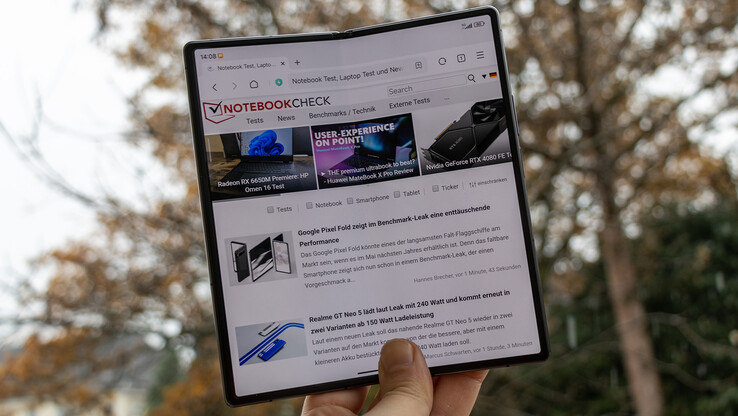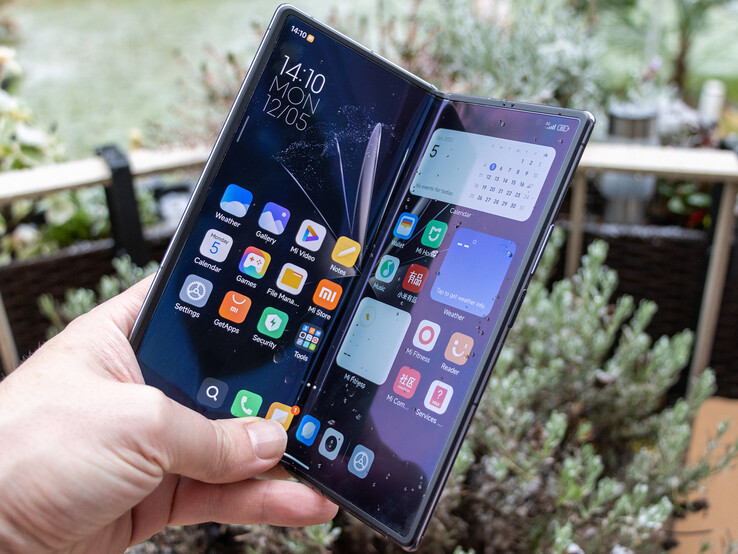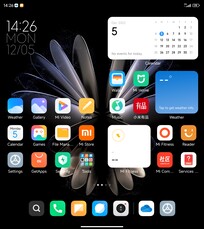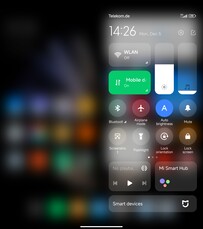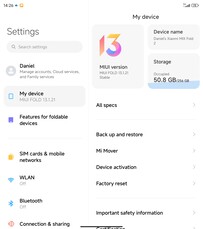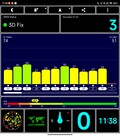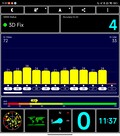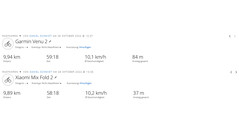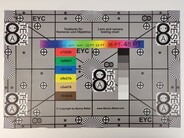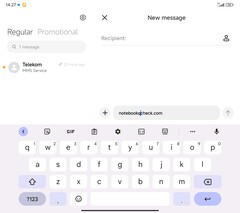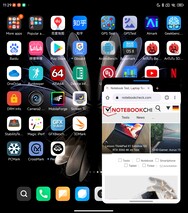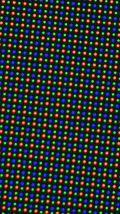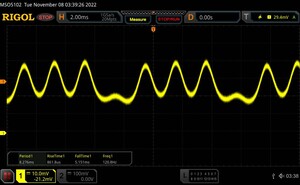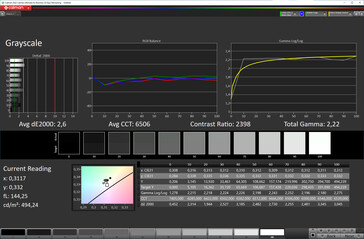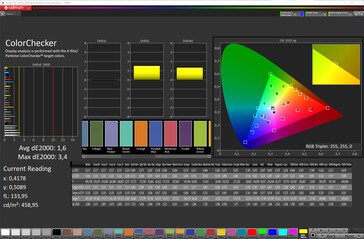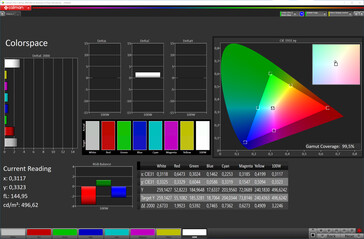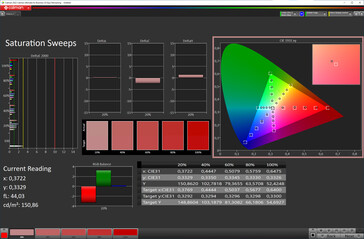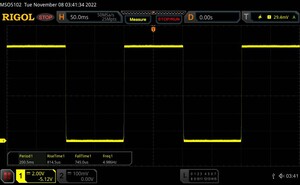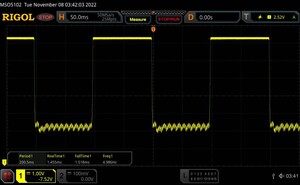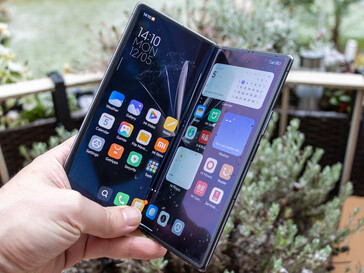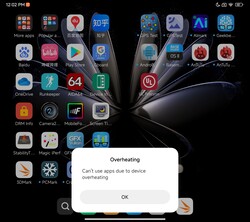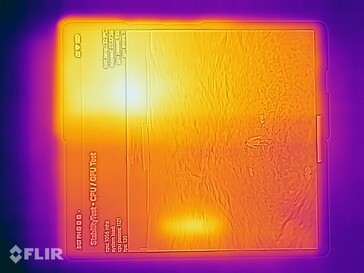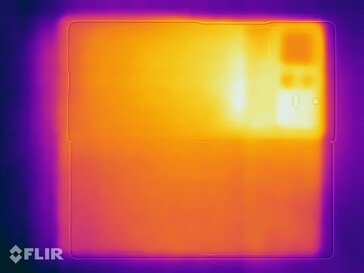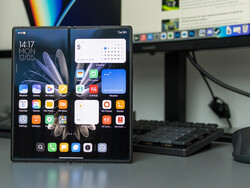Xiaomi Mix Fold 2 review - A slim, foldable smartphone with a Leica camera
The Xiaomi Mix Fold 2 follows the Mi Mix Fold which we sadly didn't get to review last year. Xiaomi's foldable has improved in every area and has also received a design makeover.
The rear-facing triple camera system has been optimized in cooperation with Leica, the device is noticeably lighter in the hand and also boasts a current SoC. However, the foldable suffers from a number of shortcomings, especially when compared to the market segment's top dog - the Samsung Galaxy Z Fold4 - a device also currently cheaper than the Mix Fold 2. Find out more in our review.
Possible competitors compared
Rating | Date | Model | Weight | Drive | Size | Resolution | Price |
|---|---|---|---|---|---|---|---|
| 86.3 % v7 (old) | 12 / 2022 | Xiaomi Mix Fold 2 SD 8+ Gen 1, Adreno 730 | 262 g | 256 GB UFS 3.1 Flash | 8.02" | 2160x1914 | |
| 89.8 % v7 (old) | 10 / 2022 | Samsung Galaxy Z Fold4 5G SD 8+ Gen 1, Adreno 730 | 263 g | 256 GB UFS 3.1 Flash | 7.60" | 2176x1812 | |
| 86.9 % v7 (old) | 08 / 2022 | Vivo X Fold SD 8 Gen 1, Adreno 730 | 311 g | 256 GB UFS 3.1 Flash | 8.03" | 2160x1916 | |
| 84.1 % v7 (old) | 09 / 2022 | Huawei Mate Xs 2 SD 888 4G, Adreno 660 | 255 g | 512 GB UFS 3.1 Flash | 7.80" | 2480x2220 |
Case - A slim and light Xiaomi foldable
The Xiaomi Mix Fold 2 is available in the color variants Moon Shadow (anthracite) and Star Gold (gold). The aluminum frame is highly polished and the external glass consists of Corning Gorilla Glass Victus. Even the camera side's matte glass turns out to be a fingerprint magnet. Xiaomi has applied a screen protector to the foldable panel and a crease can be both seen and felt.
The Mix Fold 2's design and finish are both impressive. When folded it is only 11.2 millimeters thick and considerably slimmer than the Fold4 (16 mm). In the hand, the device hardly feels thicker than an iPhone 14 Pro Max in a case and fits comfortably in a trouser pocket without feeling bulky. When opened, the foldable smartphone is only 5.4 millimeters thick. It looks and feels good but doesn't exactly make the most sturdy of impressions. It doesn't creak when being carefully twisted but there is a lot of play in the hinge area.
The gap dimensions are tight and even. The high-quality impression is spoiled somewhat by the thick, matte plastic frame which encloses the device. The SIM slot cover doesn't close flush with the frame and it is of ever-so-slightly different color than the rest of our dark model. On top of that, IP certification is conspicuously absent.
Features - Xiaomi Mix Fold 2 with USB 2.0 and IR blaster
In terms of features, not everything the Xiaomi Fold 2 has to offer is high-end. For example, the USB port uses only the 2.0 standard and doesn't support video output. In addition, Bluetooth 5.2 and Wi-Fi 6 are less than what the SoC is capable of and a UWB chip is completely missing in action.
However, OTG is not a problem, meaning peripheral devices as well as storage media can be connected to the foldable. Additionally, an IR blaster is integrated in the frame, with which your home entertainment system, air conditioning, and cameras can all be operated.
Software - Xiaomi Smartphone with Android 12 and MIUI 13.1
The Xiaomi Mix Fold 2 uses MIUI 13.1 which is based on Android 12. Google Framework and related services are preinstalled with only Play Store requiring side loading onto our Chinese model. If bought from our sales partner TradingShenzhen, this service is already on board.
The foldable is limited to five system languages: simplified Chinese, traditional Chinese, Tibetan, Uyghur, and English. Accordingly, many Chinese region apps come preinstalled but can all be deinstalled.
At the time of review, security patches are from September 1, 2022, and are therefore no longer up-to-date. Up to now, Xiaomi has not yet supplied any information regarding how long updates will be supported.
The smartphone possesses DRM certification (Widevine L1). In every-day use, we were unable to detect any problems when using streaming services such as Disney+, RTL+, YouTube or Netflix. Although HD streaming was possible with all of those service providers, HDR was absent.
Communication and GNSS - The Mix Fold 2 comes without 6 GHz Wi-Fi
The Xiaomi Mix Fold 2 supports Wi-Fi 6 and can connect to both 2.4 and 5.0 GHz networks. The Wi-Fi range is good and transfer rates were decent and stable with our Asus ROG Rapture GT-AXE11000 reference router.
Frequency coverage for mobile communications is quite good but could be better considering the price range. No problems could be found in extensive urban networks.
| Networking | |
| iperf3 receive AXE11000 | |
| Vivo X Fold | |
| Samsung Galaxy Z Fold4 5G | |
| Xiaomi Mix Fold 2 | |
| Average of class Smartphone (52 - 1857, n=182, last 2 years) | |
| Huawei Mate Xs 2 | |
| iperf3 transmit AXE11000 | |
| Xiaomi Mix Fold 2 | |
| Samsung Galaxy Z Fold4 5G | |
| Vivo X Fold | |
| Huawei Mate Xs 2 | |
| Average of class Smartphone (49.8 - 1828, n=182, last 2 years) | |
The Xiaomi Mix Fold 2 is able to use satellite networks on every possible frequency band. Even indoors, satellite fix takes place very quickly and requires only a few seconds in order to accurately determine the current location.
On a small bike tour, the foldable faced competition and comparison in the form of the Garmin Venu 2. On an almost ten kilometres long trip, both devices only experienced a 50 metre deviation during the recorded route. Also in the detailed analysis, the Mix Fold 2 showed itself to be very accurate, and only when located between two houses was it found to be a little off-route.
Telephone functions and voice quality
The Xiaomi Mix Fold 2 supports Wi-Fi calls, VoLTE, and call recording. Although space is provided for two Nano SIM cards (dual SIM), eSIM is not supported.
We liked the voice quality particularly when the smartphone is held close to the ear. The speaker reverberates a bit and the microphone range can only be described as average. Likewise, smaller ambient noises are successfully suppressed but in noisier environments, the foldable soon reaches its limits.
Cameras - A triple camera system in cooperation with Leica
On the small external display, the Xiaomi Mix Fold 2 has a front camera which snaps photos at 20 MPix and records videos at 1080p up to 60 FPS. Selfies can be described as average and are defined by poor contrast.
No camera is integrated into the large main display. Instead, the main camera can be used for selfies. The Mix Fold 2 simply uses the external panel as a viewfinder. Portrait mode delivers different results from the dedicated front camera, although this time Xiaomi exaggerates the contrast somewhat.
This is reflected in the photos taken in photo mode which all display high levels of saturation and high contrast. Dynamics also suffer as a result so we would expect more from the IMX766 sensor. The Leica cooperation can be seen in the form of both photo modes: "Leica Vibrant" and "Leica Authentic“ with the former being preset. It's difficult to spot large differences and varying color calibrations only become noticeable when compared directly to one another. Using "Authentic" mode, these are somewhat more brilliant, but the image sharpening appears more extreme. However, both benefit the photos taken.
The additional wide-angle sensor fails to impress. The images are void of dynamics and possess a visible blue tint. Neither does the Mix Fold 2 cover itself in glory when zooming. Considering the price bracket, more should be on offer in this regard.
At best, videos are recorded in 8K at 24 FPS (maximum 6 minutes). All other resolutions are used either at 30 or 60 FPS. The recorded aspect ratio is 16:9 but the option, "Movie Frame" can be activated, simulating the 21:9 format by adding black bars to the top and bottom of the photo.
Image comparison
Choose a scene and navigate within the first image. One click changes the position on touchscreens. One click on the zoomed-in image opens the original in a new window. The first image shows the scaled photograph of the test device.
HauptkameraHauptkameraUltraweitwinkel5-facher ZoomLow-Light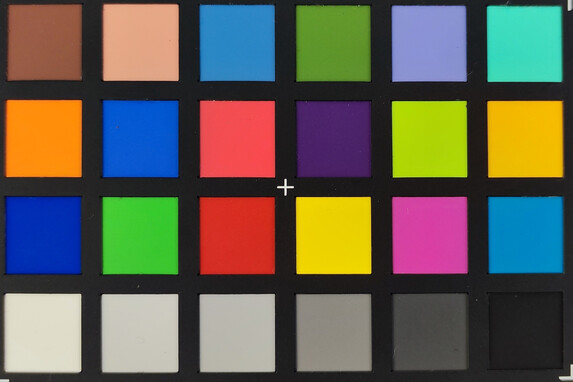

Accessories and guarantee - The Mix Fold 2 is feature-packed
In the box, the Xiaomi Mix Fold 2 comes with a modular 67 watt charger (Type A connector), a USB cable (type-A to type-C), a SIM tool, a protective case with an integrated stand as well as a USB adapter (type-C to 3.5 mm).
The guarantee is for 12 months and cannot be extended.
Input devices & operation - A foldable with a fingerprint scanner in the power on button
The Xiaomi Mix Fold 2's screens work flawlessly and respond reliably to input. Both screens receive additional protection in the form of screen protectors. It's worth pointing out, the foldable panel's protector cannot be removed.
Concerning biometric security, a fingerprint scanner is integrated into the power on button. This may be very narrow but it still manages to deliver a decent recognition rate. This button can also recognize double-tap gestures and carry out predefined actions. These include launching the camera app, taking a screenshot, opening the calculator app and much more. Additionally, face unlocking is possible via the external display's front camera. It does this quicker and more reliably but at the expense of security.
The large panel is built for multitasking. With so-called Floating Windows, suitably optimized apps can be minimized on the home screen or opened apps can be stacked. However, this is only possible with a limited number of applications. Surprisingly, Xiaomi has not appeared to optimize its own apps in this way. For anyone wishing to run multiple apps side by side, the Galaxy Z Fold4 offers considerably more options.
Displays - The Mix Fold 2 with two very bright 120 Hz OLEDs
The Xiaomi Mix Fold 2's external display measures 6.56 inches (21:9), uses AMOLED technology and operates at 120 Hz. According to information from Xiaomi, it is not an LTPO panel. However, that is not the case with the 8.02 inch OLED main display as it is LTPO 2.0 making for a possibility to lower the display's refresh rate down to 1 Hz when that's needed.
Both displays share relatively identical brightness and can reach up to 1,030 cd/m² when displaying a completely white image with the ambient light sensor activated. We even measured up to a maximum of 1,299 cd/m² with APL18. When setting the display brightness manually, 506 cd/m² are available.
PWM control works the same on both panels. At minimum display brightness, we recorded a very unstable periodic cycle of between 242 and 491 Hz. However, if the smartphone notices that it is dark it switches automatically to a DC dimming mode. Subsequently, only a constant 120 Hz frequency can be measured. Temporal dithering is not used.
| |||||||||||||||||||||||||
Brightness Distribution: 98 %
Center on Battery: 1015 cd/m²
Contrast: ∞:1 (Black: 0 cd/m²)
ΔE ColorChecker Calman: 1.6 | ∀{0.5-29.43 Ø4.79}
ΔE Greyscale Calman: 2.6 | ∀{0.09-98 Ø5}
99.5% sRGB (Calman 2D)
Gamma: 2.22
CCT: 6506 K
| Xiaomi Mix Fold 2 OLED, 2160x1914, 8" | Samsung Galaxy Z Fold4 5G Dynamic AMOLED, 2176x1812, 7.6" | Vivo X Fold AMOLED, 2160x1916, 8" | Huawei Mate Xs 2 OLED, 2480x2220, 7.8" | |
|---|---|---|---|---|
| Screen | 2% | -2% | -45% | |
| Brightness middle (cd/m²) | 1015 | 913 -10% | 730 -28% | 763 -25% |
| Brightness (cd/m²) | 1022 | 929 -9% | 724 -29% | 769 -25% |
| Brightness Distribution (%) | 98 | 96 -2% | 95 -3% | 95 -3% |
| Black Level * (cd/m²) | ||||
| Colorchecker dE 2000 * | 1.6 | 1.7 -6% | 1.66 -4% | 2.8 -75% |
| Colorchecker dE 2000 max. * | 3.4 | 3.6 -6% | 2.92 14% | 5.9 -74% |
| Greyscale dE 2000 * | 2.6 | 1.5 42% | 1.6 38% | 4.3 -65% |
| Gamma | 2.22 99% | 2.16 102% | 2.28 96% | 2.24 98% |
| CCT | 6506 100% | 6515 100% | 6395 102% | 6457 101% |
* ... smaller is better
Screen Flickering / PWM (Pulse-Width Modulation)
| Screen flickering / PWM detected | 120 Hz | ||
The display backlight flickers at 120 Hz (worst case, e.g., utilizing PWM) . The frequency of 120 Hz is very low, so the flickering may cause eyestrain and headaches after extended use. In comparison: 53 % of all tested devices do not use PWM to dim the display. If PWM was detected, an average of 8156 (minimum: 5 - maximum: 343500) Hz was measured. | |||
PWM frequency changes on different brightness levels
The main panel's color representation is very accurate as long as the color profile Original is chosen. This uses the smaller sRGB color space. The factory settings use Vivid which offers not only a cooler image but also has more heavily saturated colors and uses DCI-P3.
Display Response Times
| ↔ Response Time Black to White | ||
|---|---|---|
| 1.56 ms ... rise ↗ and fall ↘ combined | ↗ 0.8145 ms rise | |
| ↘ 0.745 ms fall | ||
| The screen shows very fast response rates in our tests and should be very well suited for fast-paced gaming. In comparison, all tested devices range from 0.1 (minimum) to 240 (maximum) ms. » 8 % of all devices are better. This means that the measured response time is better than the average of all tested devices (20.3 ms). | ||
| ↔ Response Time 50% Grey to 80% Grey | ||
| 2.97 ms ... rise ↗ and fall ↘ combined | ↗ 1.455 ms rise | |
| ↘ 1.518 ms fall | ||
| The screen shows very fast response rates in our tests and should be very well suited for fast-paced gaming. In comparison, all tested devices range from 0.165 (minimum) to 636 (maximum) ms. » 11 % of all devices are better. This means that the measured response time is better than the average of all tested devices (31.7 ms). | ||
Outdoors the Xiaomi Mix Fold 2 makes a great impression and possesses enough in the way of brightness reserves to remain perfectly readable, even on sunny days.
Image angle stability is very good but the display suffers from considerable darkening when viewed from a very wide angle.
Performance - Snapdragon 8+ Gen 1 in the Xiaomi foldable
The Xiaomi Mix Fold 2 uses a Snapdragon 8+ Gen 1 with 12 GB LPDDR5 RAM and is therefore based on powerful foundations. The device not only ran at expected levels in our benchmark tests but was similarly impressive when processing everyday tasks. It performs slightly below average in system benchmarks but this is not noticeable due to the overall power of the device.
| Antutu v9 - Total Score | |
| Xiaomi Mix Fold 2 | |
| Average Qualcomm Snapdragon 8+ Gen 1 (782013 - 1119358, n=23) | |
| Samsung Galaxy Z Fold4 5G | |
| Average of class Smartphone (99654 - 2056989, n=34, last 2 years) | |
| CrossMark - Overall | |
| Samsung Galaxy Z Fold4 5G | |
| Average of class Smartphone (187 - 2674, n=131, last 2 years) | |
| Average Qualcomm Snapdragon 8+ Gen 1 (749 - 1178, n=23) | |
| Xiaomi Mix Fold 2 | |
| UL Procyon AI Inference for Android - Overall Score NNAPI | |
| Samsung Galaxy Z Fold4 5G | |
| Xiaomi Mix Fold 2 | |
| Average Qualcomm Snapdragon 8+ Gen 1 (3291 - 84787, n=21) | |
| Average of class Smartphone (3769 - 81594, n=138, last 2 years) | |
| AImark - Score v3.x | |
| Average Qualcomm Snapdragon 8+ Gen 1 (887 - 147801, n=11) | |
| Average of class Smartphone (82 - 307528, n=127, last 2 years) | |
| Xiaomi Mix Fold 2 | |
The integrated Adreno 730 is in charge of graphics processing and delivers on its promise of high performance. Benchmark tests show that the implemented cooling system is not sufficient as the Mix Fold 2 doesn't fare so well in modern GFXBench onscreen tests.
GFXBench (DX / GLBenchmark) 2.7: T-Rex Onscreen | 1920x1080 T-Rex Offscreen
GFXBench 3.0: on screen Manhattan Onscreen OGL | 1920x1080 1080p Manhattan Offscreen
GFXBench 3.1: on screen Manhattan ES 3.1 Onscreen | 1920x1080 Manhattan ES 3.1 Offscreen
GFXBench: on screen Car Chase Onscreen | 1920x1080 Car Chase Offscreen | on screen Aztec Ruins High Tier Onscreen | 2560x1440 Aztec Ruins High Tier Offscreen | on screen Aztec Ruins Normal Tier Onscreen | 1920x1080 Aztec Ruins Normal Tier Offscreen
| 3DMark / Wild Life Extreme Unlimited | |
| Samsung Galaxy Z Fold4 5G | |
| Xiaomi Mix Fold 2 | |
| Vivo X Fold | |
| Huawei Mate Xs 2 | |
| 3DMark / Wild Life Extreme | |
| Xiaomi Mix Fold 2 | |
| Samsung Galaxy Z Fold4 5G | |
| Vivo X Fold | |
| Huawei Mate Xs 2 | |
| 3DMark / Wild Life Unlimited Score | |
| Samsung Galaxy Z Fold4 5G | |
| Xiaomi Mix Fold 2 | |
| Huawei Mate Xs 2 | |
| 3DMark / Wild Life Score | |
| Huawei Mate Xs 2 | |
| 3DMark / Sling Shot Extreme (ES 3.1) Unlimited Physics | |
| Xiaomi Mix Fold 2 | |
| Samsung Galaxy Z Fold4 5G | |
| Huawei Mate Xs 2 | |
| 3DMark / Sling Shot Extreme (ES 3.1) Unlimited Graphics | |
| Samsung Galaxy Z Fold4 5G | |
| Xiaomi Mix Fold 2 | |
| Huawei Mate Xs 2 | |
| 3DMark / Sling Shot Extreme (ES 3.1) Unlimited | |
| Xiaomi Mix Fold 2 | |
| Samsung Galaxy Z Fold4 5G | |
| Huawei Mate Xs 2 | |
| GFXBench (DX / GLBenchmark) 2.7 / T-Rex Onscreen | |
| Samsung Galaxy Z Fold4 5G | |
| Xiaomi Mix Fold 2 | |
| Huawei Mate Xs 2 | |
| GFXBench (DX / GLBenchmark) 2.7 / T-Rex Offscreen | |
| Xiaomi Mix Fold 2 | |
| Samsung Galaxy Z Fold4 5G | |
| Huawei Mate Xs 2 | |
| GFXBench 3.0 / Manhattan Onscreen OGL | |
| Samsung Galaxy Z Fold4 5G | |
| Xiaomi Mix Fold 2 | |
| Huawei Mate Xs 2 | |
| GFXBench 3.0 / 1080p Manhattan Offscreen | |
| Xiaomi Mix Fold 2 | |
| Samsung Galaxy Z Fold4 5G | |
| Huawei Mate Xs 2 | |
| GFXBench 3.1 / Manhattan ES 3.1 Onscreen | |
| Samsung Galaxy Z Fold4 5G | |
| Xiaomi Mix Fold 2 | |
| Huawei Mate Xs 2 | |
| GFXBench 3.1 / Manhattan ES 3.1 Offscreen | |
| Xiaomi Mix Fold 2 | |
| Samsung Galaxy Z Fold4 5G | |
| Huawei Mate Xs 2 | |
| GFXBench / Car Chase Onscreen | |
| Samsung Galaxy Z Fold4 5G | |
| Xiaomi Mix Fold 2 | |
| Huawei Mate Xs 2 | |
| GFXBench / Car Chase Offscreen | |
| Xiaomi Mix Fold 2 | |
| Samsung Galaxy Z Fold4 5G | |
| Huawei Mate Xs 2 | |
| GFXBench / Aztec Ruins High Tier Onscreen | |
| Samsung Galaxy Z Fold4 5G | |
| Vivo X Fold | |
| Xiaomi Mix Fold 2 | |
| Huawei Mate Xs 2 | |
| GFXBench / Aztec Ruins High Tier Offscreen | |
| Samsung Galaxy Z Fold4 5G | |
| Vivo X Fold | |
| Xiaomi Mix Fold 2 | |
| Huawei Mate Xs 2 | |
| GFXBench / Aztec Ruins Normal Tier Onscreen | |
| Samsung Galaxy Z Fold4 5G | |
| Vivo X Fold | |
| Xiaomi Mix Fold 2 | |
| Huawei Mate Xs 2 | |
| GFXBench / Aztec Ruins Normal Tier Offscreen | |
| Xiaomi Mix Fold 2 | |
| Vivo X Fold | |
| Samsung Galaxy Z Fold4 5G | |
| Huawei Mate Xs 2 | |
| Jetstream 2 - 2.0 Total Score | |
| Average of class Smartphone (23.8 - 387, n=155, last 2 years) | |
| Samsung Galaxy Z Fold4 5G (Chrome 105) | |
| Average Qualcomm Snapdragon 8+ Gen 1 (76.2 - 204, n=23) | |
| Xiaomi Mix Fold 2 (MiUI-Browser 14.7) | |
| Speedometer 2.0 - Result 2.0 | |
| Average of class Smartphone (15.2 - 643, n=132, last 2 years) | |
| Average Qualcomm Snapdragon 8+ Gen 1 (69.1 - 196, n=18) | |
| Samsung Galaxy Z Fold4 5G (Chrome 105) | |
| WebXPRT 4 - Overall | |
| Average of class Smartphone (27 - 306, n=148, last 2 years) | |
| Samsung Galaxy Z Fold4 5G (Chrome 105) | |
| Average Qualcomm Snapdragon 8+ Gen 1 (69 - 159, n=21) | |
| Xiaomi Mix Fold 2 | |
| WebXPRT 3 - Overall | |
| Samsung Galaxy Z Fold4 5G (Chrome 105) | |
| Average of class Smartphone (38 - 380, n=41, last 2 years) | |
| Average Qualcomm Snapdragon 8+ Gen 1 (106 - 224, n=14) | |
| Octane V2 - Total Score | |
| Samsung Galaxy Z Fold4 5G (Chrome 105) | |
| Average of class Smartphone (2228 - 121337, n=201, last 2 years) | |
| Average Qualcomm Snapdragon 8+ Gen 1 (17622 - 61536, n=24) | |
| Xiaomi Mix Fold 2 (MiUI-Browser 14.7) | |
| Huawei Mate Xs 2 (Huawei Browser 12.1) | |
| Mozilla Kraken 1.1 - Total | |
| Xiaomi Mix Fold 2 (MiUI-Browser 14.7) | |
| Average of class Smartphone (257 - 28190, n=156, last 2 years) | |
| Average Qualcomm Snapdragon 8+ Gen 1 (665 - 1707, n=22) | |
| Samsung Galaxy Z Fold4 5G (Chrome 105) | |
* ... smaller is better
| Xiaomi Mix Fold 2 | Samsung Galaxy Z Fold4 5G | Vivo X Fold | Huawei Mate Xs 2 | Average 256 GB UFS 3.1 Flash | Average of class Smartphone | |
|---|---|---|---|---|---|---|
| AndroBench 3-5 | -19% | -14% | -29% | -21% | -4% | |
| Sequential Read 256KB (MB/s) | 1882.11 | 1854.98 -1% | 1850.6 -2% | 1850.72 -2% | 1757 ? -7% | 2212 ? 18% |
| Sequential Write 256KB (MB/s) | 1783.27 | 1251.57 -30% | 1405 -21% | 739.83 -59% | 1204 ? -32% | 1835 ? 3% |
| Random Read 4KB (MB/s) | 342.67 | 321.87 -6% | 293.4 -14% | 260.49 -24% | 287 ? -16% | 293 ? -14% |
| Random Write 4KB (MB/s) | 446.48 | 265.9 -40% | 358.1 -20% | 301.38 -32% | 318 ? -29% | 338 ? -24% |
Emissions - The stress test is too hot to handle
Temperature
Although the Xiaomi Mix Fold 2's surface temperatures hold up well even under load, our stress tests presented a mixed picture.
During the reasonably demanding 3DMark Wild Life Extreme stress test, the system remained stable, running at a full frame rate. However, this strangely doesn't, for example, apply to the normal stress test which was aborted in order to protect the system from overheating.
(+) The maximum temperature on the upper side is 33.6 °C / 92 F, compared to the average of 35.2 °C / 95 F, ranging from 21.9 to 247 °C for the class Smartphone.
(+) The bottom heats up to a maximum of 32.6 °C / 91 F, compared to the average of 34 °C / 93 F
(+) In idle usage, the average temperature for the upper side is 27.5 °C / 82 F, compared to the device average of 32.9 °C / 91 F.
3DMark Wild Life Stress Test
| 3DMark | |
| Wild Life Stress Test Stability | |
| Huawei Mate Xs 2 | |
| Samsung Galaxy Z Fold4 5G | |
| Wild Life Extreme Stress Test | |
| Xiaomi Mix Fold 2 | |
| Samsung Galaxy Z Fold4 5G | |
| Huawei Mate Xs 2 | |
Speakers
Both speakers have been tuned by Harman Kardon and support Dolby Atmos. The playback is decent but didn't really knock us off our feet. Above all, the speakers are overwhelmed by deep tones.
The Xiaomi smartphone offers almost complete Bluetooth codec support, including aptX Adaptive and TWS+. Wired headphones can be connected via the USB-C port and a suitable adapter for the 3.5 mm jack comes as standard.
Xiaomi Mix Fold 2 audio analysis
(+) | speakers can play relatively loud (84 dB)
Bass 100 - 315 Hz
(-) | nearly no bass - on average 24.3% lower than median
(±) | linearity of bass is average (11.1% delta to prev. frequency)
Mids 400 - 2000 Hz
(+) | balanced mids - only 3.5% away from median
(+) | mids are linear (4.7% delta to prev. frequency)
Highs 2 - 16 kHz
(+) | balanced highs - only 4.6% away from median
(+) | highs are linear (3.6% delta to prev. frequency)
Overall 100 - 16.000 Hz
(±) | linearity of overall sound is average (18% difference to median)
Compared to same class
» 15% of all tested devices in this class were better, 8% similar, 76% worse
» The best had a delta of 11%, average was 35%, worst was 134%
Compared to all devices tested
» 37% of all tested devices were better, 8% similar, 56% worse
» The best had a delta of 4%, average was 24%, worst was 134%
Samsung Galaxy Z Fold4 5G audio analysis
(+) | speakers can play relatively loud (87.4 dB)
Bass 100 - 315 Hz
(-) | nearly no bass - on average 20.6% lower than median
(±) | linearity of bass is average (9.7% delta to prev. frequency)
Mids 400 - 2000 Hz
(+) | balanced mids - only 4% away from median
(+) | mids are linear (3.9% delta to prev. frequency)
Highs 2 - 16 kHz
(±) | higher highs - on average 6% higher than median
(+) | highs are linear (3.5% delta to prev. frequency)
Overall 100 - 16.000 Hz
(±) | linearity of overall sound is average (16.3% difference to median)
Compared to same class
» 6% of all tested devices in this class were better, 5% similar, 89% worse
» The best had a delta of 11%, average was 35%, worst was 134%
Compared to all devices tested
» 26% of all tested devices were better, 6% similar, 69% worse
» The best had a delta of 4%, average was 24%, worst was 134%
Battery life - 4500 mAh with two batteries
Power consumption
Power consumption is low but could be lower during idle usage.
With the supplied 67 watt charger, the battery can be fully recharged within 45 minutes. However, wireless charging is not supported.
| Off / Standby | |
| Idle | |
| Load |
|
Key:
min: | |
| Xiaomi Mix Fold 2 4500 mAh | Samsung Galaxy Z Fold4 5G 4400 mAh | Average Qualcomm Snapdragon 8+ Gen 1 | Average of class Smartphone | |
|---|---|---|---|---|
| Power Consumption | 11% | -28% | -29% | |
| Idle Minimum * (Watt) | 0.97 | 0.89 8% | 1.006 ? -4% | 0.853 ? 12% |
| Idle Average * (Watt) | 1.37 | 0.96 30% | 1.834 ? -34% | 1.43 ? -4% |
| Idle Maximum * (Watt) | 1.48 | 1.13 24% | 1.984 ? -34% | 1.609 ? -9% |
| Load Average * (Watt) | 3.98 | 4.32 -9% | 5.68 ? -43% | 7.09 ? -78% |
| Load Maximum * (Watt) | 6.83 | 6.56 4% | 8.44 ? -24% | 11.2 ? -64% |
* ... smaller is better
Power consumption: Geekbench (150 cd/m²)
Power consumption: GFXBench (150 cd/m²)
Battery life
In the area of battery life, the Xiaomi Mix Fold 2 managed a respectable result in our practical Wi-Fi test with an adaptive display brightness of 150 cd/m². The test was carried out using the main display's adaptive 120 Hz mode.
The Fold 2 isn't exactly a marathon runner and is only just able to edge past the Huawei Mate Xs 2 in our comparison box.
| Battery runtime - WiFi v1.3 (sort by value) | |
| Xiaomi Mix Fold 2 | |
| Samsung Galaxy Z Fold4 5G | |
| Vivo X Fold | |
| Huawei Mate Xs 2 | |
Pros
Cons
Verdict - Xiaomi has the slimmest foldable around
The Xiaomi Mix Fold 2 is a powerful, foldable smartphone with an impressively slim design in spite of being only marginally thicker than a traditional smartphone in a case. Likewise, everyday performance is excellent but the aborted stress gives us cause for concern regarding its ability to cope with warm summer temperatures.
The Xiaomi Mix Fold 2 is a wonderful, foldable smartphone that ought to offer more high-end features, especially when taking its high price into consideration.
Xiaomi hasn't skimped on storage space either. In addition to the 256 GB base model, variants with 512 and even 1024 GB are available. At the time of our review, prices start at 1500 euros and for that kind of money, we would have expected a better camera. Above all, the additional lens's image processing leaves quite a bit of room for improvement that even Leica branding can't save. Xiaomi is also a little stingy with high-end features. Neither 6 GHz Wi-Fi nor UWB is integrated and unlike the top dog - the Galaxy Z Fold4 - the smartphone is neither water resistant, nor does it offer stylus support. At the moment, there aren't many alternatives and Xiaomi is certainly offering the slimmest and most pocket-friendly foldable around. Other foldable smartphones such as the Vivo X Fold as well as the Oppo Find N are likewise only available as imports.
Price and availability
The Xiaomi Mix Fold 2 is available directly and in all storage variants via our sales partner TradingShenzhen.
Xiaomi Mix Fold 2
- 12/08/2022 v7 (old)
Daniel Schmidt




